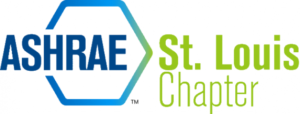Membership Promotion Meeting, Monday, October 17, 2022, 10:30 – 1pm
REGISTER NOW
TECHNICAL SESSION Design of Pressurization Systems – Technologies in Room/Suite Pressure Control, Performance Evaluation and Design Practices
MAIN SESSION Cleanrooms and HVAC Systems Design Fundamentals
WHERE: In Person & Virtual, Spazio’s Westport 2031 Lackland Rd, St. Louis, MO 63146
FEE $0 for ASHRAE St. Louis Members, Past Presidents, and full time students; $0 for Non-members
SPEAKER Wei Sun, President, Engsysco, Inc. , ASHRAE Distinguished Lecturer

BIO: Mr. Sun is an ASHRAE Fellow, he served as the Chairman of ASHRAE Technical Committee TC9.11 (Clean Spaces) from 2007-2010. He is also a member of ASHRAE Technical Committees TC9.6 (Healthcare Facilities) and TC9.10 (Laboratory Systems). He served as a Regional Vice Chair (RVC) for ASHRAE Region V (Ohio, Indiana and Michigan) in 2008-2010, and President of ASHRAE Detroit Chapter in 2010-2011. He served as ASHRAE society CTTC (Chapter Technology Transfer Committee) Vice Chair and Chair from 2011 through 2013, a past member of ASHRAE’s Honors & Awards committee, currently as a member of AHSRAE society’s Nominating committee. In other leadership roles, Mr. Sun served as the President of IEST (Institute of Environmental Science and Technology, based in Chicago) Society in 2016-2017 in charge of all society leadership and management responsibilities. He is also the USA Delegate for ISO cleanroom standards 14644 on behalf of USA since 2012. As the Principal Author, his 450-page new technical book “ASHRAE Design Guide for Cleanrooms” was published in 2017, he led over 20 co-authors and spent 6 years to accomplish this major achievement. In 2018 Mr. Sun has been also chairing the NEBB’s Cleanroom Performance Testing (CPT) Committee to develop its new edition of testing standard. In 2019 Mr. Sun received both ASHRAE society’s Distinguished Service Award (DSA) and Exceptional Service Award (ESA) which recognizes his extraordinary contributions to HVAC design, research, public speeches, management and industry leadership. Mr. Sun received his BSME from University of Shanghai for Science and Technology in China in 1985. In 1989 he was awarded with an academic scholarship from University of Kentucky and then received his MSAE degree from University of Kentucky in 1992. Since then Mr. Sun has been working in the US as a consulting engineer for 28 years in building mechanical systems design, HVAC, consulting, training and research. He is a registered Professional Engineer in many states in the United States. Prior to his current position as the President at Engsysco, Inc., he has worked for several national architectural and engineering firms in the Midwest. He has served as senior engineer, lead engineer, group leader, department head and has led the designs of many large and sophisticated cleanroom facilities, hospitals, bio-safety laboratories, and high-rise buildings. In addition to his cleanroom, hospital and laboratory design expertise, he has been serving as a Principal Investigator for many ASHRAE and governmental research projects, his research findings have been published in ASHRAE Transactions, ASHRAE Journal, Labs21(DOE/EPA), CEC Research, and his research outcomes and recommendations have been included in ASHRAE books, IEST’s Recommended Practices, and even in ISO new cleanroom standards. He led a US research consortium team to build a state-of-the-art, fully automated cleanroom test lab and new technologies demonstration center in Farmington Hills, Michigan. He has been invited to conduct numerous technical speeches and training seminars in national and international conferences, he has visited 35 countries since 2006. Mr. Sun has served as the “USA HVAC&R Advisor” for Japan Air Conditioning, Heating & Refrigeration News (JARN) magazine from 2004-2008. He also served as a “USA Consultant” for the Ministry of Health of Malaysia for their standardization effort for healthcare facilities. Mr. Sun has served as a research program/proposals reviewer for US NIOSH/CDC and DOE. In 2010 he served as the ASHRAE Society’s “Technology Awards Judging Panel” Chair. Mr. Sun is the recipient of ASHRAE Dan Mills Award for Technology Transfer in 2006, IEST’s Willis Whitfield Award in 2016, and Robert Mielke Award in 2017, and an ASHRAE Distinguished Lecturer (DL) since 2009.
Cleanrooms and HVAC Systems Design Fundamentals
This presentation addresses the fundamentals and basic knowledge of cleanrooms and HVAC systems design. The presenter included the latest technologies, practices, and approaches from the newly published “ASHRAE Design Guide for Cleanrooms” and ISO cleanroom 14644 standards where he serves as the Principal Author and USA Delegate respectively. It covers the definition and classifications of cleanrooms, cleanroom standards, airborne particulates, airborne molecular contamination (AMC), viable (microbiological) contamination, particle sources, airflow quantity, velocity, flow patterns, floor arrangement, airflow patterns, airlock and pressurization system design, HVAC, plumbing, fire protection, and process systems. It also discusses the common cleanroom devices and equipment, architectural construction materials, cleaning procedures, testing standards, construction cost and CFD simulations.
Design of Pressurization Systems – Technologies in Room/Suite Pressure Control, Performance Evaluation and Design Practices
The presentation covers some findings of a recent ASHRAE research projects (RP-1344, RP-1431) for which the speaker led these research teams on room pressure control study for critical and controlled environments. This presentation starts with the purposes of pressurization, how to achieve, basic mathematical relationship, room air-tightness, pressurization scenarios, typical pressurization criterion, control strategies such as direct pressure-differential, differential flow tracking, hybrid control and adaptive controls. Also, the types of airlocks, and how to use airlocks for various scenarios are discussed. New development on multiple-room (suite) pressure control strategies and automated room air-tightness test are discussed. Contamination (by particle, microbial, chemical fume, etc.) during door-in-operation condition and dynamic control strategies, airlock types and applications, and CFD simulation are presented and illustrated.











